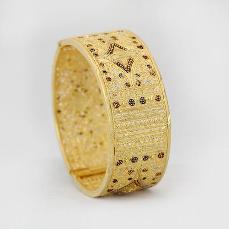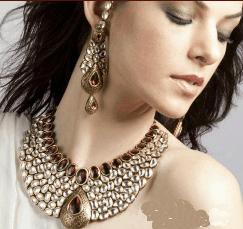Our Blog

22-carat Gold [Standard Gold]
Posted by Admin
Standard Gold of English coinage was alloyed with Ag & Cu [pale yellow color]. Since 1829, only copper used as the alloying metal in Gold coinage.
For Jewellery purpose Au is alloyed with Cu & Ag,[3 parts of Cu & 1 parts of Ag]
Therefore the resulting alloy is soft, ductile metal easily worked up into rings.
Formerly 22-carat Gold was used for watchcases & mounting rings
It is used for wedding rings
From the following table, it will be seen that hardness increases with increase in copper content.
The rate of hardening on rolling the alloy to reduce the original thickness by 60%, increases at quicker rate with Cu than when Ag only in alloying metal.
Ductility [% Elongation] is greater in 22-carat Gold when alloyed with Ag than when alloyed with Cu.
The Ductility is least when Cu & Ag are present in about equal proportions
more
20-carat Gold
20-parts of fine Gold & 4-parts of alloying metal.
It was a legal standard of Gold in Ireland in 1783 & still in use.
Ascot Gold cup is made from this quality Gold.
more
18-carat Gold
18-parts of fine Gold & 8-parts of alloying metal.
It is used for Rings, Brooches, Chains, Watchcases, Medals [Au-Ag alloy], Ornamental Brooches [Green Gold].
18-carat Gold with equal parts of Ag & Cu [12.5% each] produces the Gold with medium color & is suitable for any class of work.
With above proportions the alloy has good ductility & medium hardness, is tough so that in Gem setting it is easily affected.
more
more

EFFECT OF ALLOYING ON GOLD:-
Posted by Admin
The gold alloys used in the Jewellery are described by karat and color.
Gold can be alloyed with most of the metals and it any proportion.
The proportion & metal(s) used determines the color of the alloy, its working qualities and its suitability for use in fabrication, casting, or Enameling.
[A] EFFECT OF FUSIBILITY:-
The fusibility of Jewelery alloy is with in a convenient of range of temperature.
The M.P. of Gold is lowered by addition of these metals.
more
Note: -
Most fusible alloy with the combination of Au, Ag, Cu contains
40% Au, 23-35% Cu & remaining Silver
This alloy melts at 790oC
The range of temperature of longer or shorter duration is termed as Pasty stage.
The duration of Pasty stage varies according to the composition of the alloy.
Effects of varying Ag & Cu contents on the M.P. of Au-Ag-Cu karat Gold alloys:-
Approximate M.P. of different Gold alloys:-

[B] Coloring Effects:-
The colors of gold alloys generally fall into the color groups
Red, Yellow, Green, White
Other colored alloy exists, but are rarely used. Most of the colored alloys used in the Jewellery are Ternary alloys.
Note: -
White Gold is hard & brittle and difficult to work. It is used with Diamonds.
Red Gold is used with yellow for contrasting effects.
Electrum is used for Antique Jewelery.
Note: -
Color control & matching is an important feature in the fabrication of karat Gold Jewellery & in the production of decorative Gold coatings. Colored Gold alloys are used for Cigarette cases, Bracelets, Chains, and Sleeve-links etc.
Natural color is obtained by alloying the Gold with the other metals that have a distinctive coloring influence on the characteristic yellow of pure Gold [& not to the colored Gold of low quality alloys]
Note: -
Color of a Gold alloy is frequently of paramount importance to the manufacturing Jewelers. In special cases the working properties of an alloy will be sacrificed to a limited extent in order to obtain desired tint.
The alloy must possess physical properties of malleability & ductility so that the alloy must be of the quality or karat which is legally saleable.
Coloring effects are produced by addition of Ag &Cu
1. White Gold: -
Addition of Ag to Au produces alloys paler in color as the % of Ag is increased.
With 60% Ag & remaining Au, the alloy is white & resemble Ag.
Therefore the alloy containing 90% Ag + 10% Au is sold as White Gold for use in Gem setting, Diamonds. This alloy keeps its color for much longer period than Pure Silver.
2. Green Gold: - Green Gold known to ancients [Natural alloys of Au & Ag] as Electrums. With 25% Ag, Gold assumes peculiar greenish yellow tint.
Note: -
Green tint is seen when the piece of sheet metal is coiled so that light is repeatedly reflected from surface to surface.
3. Red Gold: -
Addition of Copper heightens the yellow color of Gold
Alloy passing through grades of Yellow Red Yellow Rich Red, as the proportion of Copper is increased.
4. Yellow Gold: -
Both Cu & Ag are added at the same time, the two metals counteract the coloring effects of each other. Therefore the Ternary alloy [Au-Ag-Cu] can be produced closely resembling the yellow color of Pure Gold.

GOLD & ITS ALLOYS
Posted by Admin
KARAT SYSTEM
Pure gold is too soft to be used in the Jewellery. It is therefore alloyed with other metals [silver, copper, nickel, zinc, palladium, etc. to make it harder, to produce cheaper alloy of specific quality or one having a distinct color.
For the purpose of identification and quality control the percentage of gold in all the gold alloys is standardized.This karat system is used for denoting the standard quality or established proportion of pure gold or fine gold in an alloy.
NOTE: - There is no relation to the karat used for weighing diamonds, pearls, and others.
Therefore pure gold is 24-karat gold and the alloy, which are legal, completely Hallmarked are called as 23,22,18,15,12,9 karat alloys. These numbers indicate the parts of pure gold in 24 parts of alloys.
For Hallmarking purpose the quality or standard of gold is expressed in decimals or in parts per thousand or millesimal fineness i.e. pure gold is regarded as 1000 fine.
more
PROPERTIES OF PURE GOLD OR FINE WIRE: -
Gold is the most important metal to be used in the Jewellery trade but it is used very little in the pure state.
Because, the metal [pure gold] is too soft and its tensile strength too low for everyday usage.
Addition of small amount of others metals results in marked increase in hardness and strength. Therefore pure gold is alloyed with other metals for industrial purposes. The metals used determines the color of the alloys, its working qualities and its suitability for use in fabrication, casting or enameling.
Properties of Pure Gold: -
There is increase in hardness, tensile strength and elasticity.
There is marked decrease in ductility [Elongation test]
Tensile strength and limit of elasticity is in tons/ inch2
Brinell hardness test for 10mm steel ball and load= 500kg.
Elongation test shows tenacity and ductility are in percentage of original length.
more